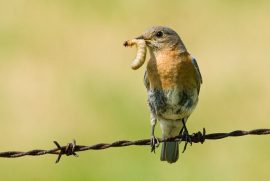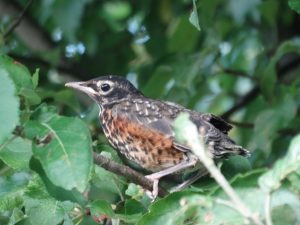By Ashley Peele

Great Blue Heron with stick at Richmond Rookery (Bob Schamerhorn)
Mid-June has somehow already arrived, which means that confirmed breeding codes are springing up on many checklists. We’re excited to see volunteers adding new species confirmations to their blocks or documenting uncommon breeding species, e.g. the Dickcissel pair recently found in Bedford county. Given this surge in breeding data, now is a great time for the last installment of our Tricky Breeding Code series.
We ended our last article by discussing the probable nest-building code (B), which applies to cavity or dummy nest-builders. Now, let’s begin this article by focusing on the confirmed code for nest-building, NB.
Nest Building – NB
This code is in some ways the opposite of code B. It applies to species that actually build nests, which covers the majority of bird species. The term ‘nest’ refers to everything from the ornately woven, hanging nests of the Baltimore Oriole to the scratch nest of a Killdeer. This code does not apply to any cavity-nesting species, which include woodpeckers, chickadees, titmice.
Carrying Nest Material – CN
Observing birds carrying grasses, twigs, bits of silk or hair, and even feathers is a common sight in the breeding season. This behavior is a great way to confirm breeding in the early part of the breeding season. However, there are a number of species that regularly carry materials that are not associated with nest-building. These species include…
- Crows and Ravens, Vultures, Brown-headed Cowbirds, Nightjars, Woodpeckers, Wrens, Wood Ducks, and Mergansers
As tempting as it may be, the CN code rarely applies to these species and thus should not be used.

Eastern Bluebird w/ mealworm (Bob Schamerhorn)
Carrying Food – CF
This code is intended for situations where adult birds are observed repeatedly carrying food in the same direction, suggesting that they are delivering food to an unseen nest. Similar to the CN code, certain species of birds frequently carry food around for courtship behaviors or their own consumption. These species include Gulls and Terns. Imagine all the times you’ve seen a gull carrying rotting fish around the beach. Such situations are not appropriate for the CF code use.
Bald Eagles, Osprey, Hawk and Falcon sp., and Corvids also frequently carry food around outside of the breeding season. However! It is of course possible for these species to be carrying food back to their nest. In this case, the CF code should only be used if you can confirm that the bird is in fact returning to a nest.
Recently Fledged Young – FL
This code is fairly straightforward. It applies to juvenile birds, either precocial or altricial (born naked and helpless) that are still dependent on parents. It is important to note that some fledgling birds are capable of ranging quite far from their natal nests and thus out of the priority block they were born in. A good rule to remember is that if a fledgling’s tail is shorter than the adults, then if probably originated locally.

American Robin fledgling (Ashley Peele)
Terns, gulls, and raptor species disperse widely from their nest sites. Only use this code for such species if you have good evidence that the nest (or nesting colony) were located within the block that you observed the fledglings in.
_______________________________________________
There are always more nuances to breeding codes that we can discuss in one article. For now, feel free to post your additional questions via the Atlas Facebook group page or send an email to your regional coordinator. Asking is always a better strategy than guessing. We appreciate the volunteers who have delved into the methods and taken the time to learn the when and how to apply breeding codes.
~Ashley Peele, VABBA2 Coordinator

